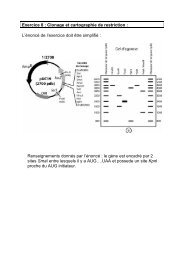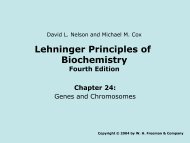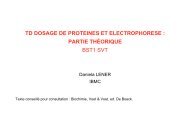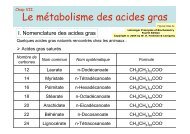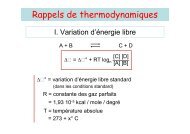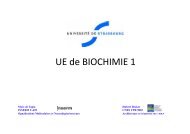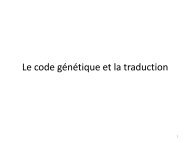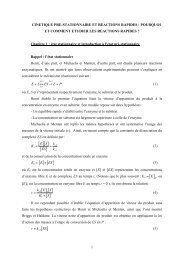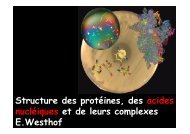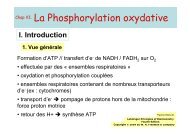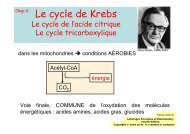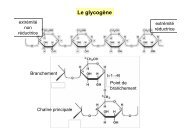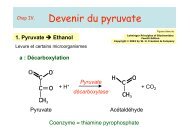La Gluconéogenèse - IBMC
La Gluconéogenèse - IBMC
La Gluconéogenèse - IBMC
You also want an ePaper? Increase the reach of your titles
YUMPU automatically turns print PDFs into web optimized ePapers that Google loves.
Chap VIII.<br />
<strong>La</strong> <strong>Gluconéogenèse</strong><br />
Synthèse de glucose à partir de lactate, acides aminés, glycérol<br />
<strong>La</strong>ctate formé par muscle squelettique en action si<br />
glycolyse >> cycle de Krebs + chaîne respiratoire<br />
Acides aminés dérivés des protéines pdt jeûne, dégradation des protéines<br />
Glycérol provient de l’hydrolyse des triglycérides<br />
FOIE (9/10è)<br />
CORTEX RENAL (1/10è)<br />
pas de gluconéogenèse dans<br />
CERVEAU et MUSCLE SQUELETTIQUE<br />
Figures tirées de<br />
Lehninger Principles of Biochemistry<br />
Fourth Edition<br />
Copyright © 2004 by W. H. Freeman & Company
I. Description de la<br />
voie de synthèse<br />
du glucose<br />
certains acides aminés<br />
<strong>La</strong>ctate<br />
Glucose<br />
Glucose 6-phosphate<br />
Fructose 6-phosphate<br />
Fructose 1,6-bisphosphate<br />
Glyceraldéhyde 3-P Dihydroxyacétone P<br />
1,3-diphosphoglycérate<br />
3-phosphoglycérate<br />
2-phosphoglycérate<br />
Phosphoénolpyruvate<br />
Oxaloacétate<br />
Pyruvate<br />
Glycérol<br />
certains acides aminés
+<br />
II. <strong>La</strong> pyruvate carboxylase<br />
a : Pyruvate + CO 2 + ATP + H2O<br />
Oxaloacétate + ADP + Pi + 2 H +<br />
pyruvate carboxylase<br />
(enzyme allostérique)<br />
(biotine, CoA)<br />
ATP ADP<br />
pyruvate carboxylase
Bilan :<br />
b. Oxaloacétate + GTP<br />
phosphoénolpyruvate carboxykinase<br />
Phosphoénolpyruvate + GDP + CO 2<br />
Pyruvate + ATP + GTP + H2O<br />
GDP<br />
CO 2<br />
Phosphoénolpyruvate<br />
carboxykinase<br />
phosphoénolpyruvate<br />
+ ADP + GDP + Pi + 2 H +<br />
Rq : souvent les décarboxylations permettent des réactions qui autrement<br />
auraient été hautement endergoniques
Formation du fructose 6-phosphate<br />
fructose 1,6 di-P + H 2O fructose 6-P + Pi<br />
fructose 1,6 diphosphatase<br />
Réaction éxergonique<br />
Formation du glucose<br />
glucose 6-P + H 2O glucose + Pi<br />
glucose 6 phosphatase<br />
enz liée au réticulum endoplasmique pas présente dans le<br />
cerveau ni dans le muscle<br />
pas de synthèse de glucose
Mécanisme d’action de la pyruvate carboxylase<br />
(Merton, Mutter, 1960)<br />
Enzyme mitochondriale<br />
Gpt prosthétique = biotine<br />
HN<br />
HC<br />
O<br />
C<br />
NH<br />
CH<br />
H2C C<br />
S<br />
H<br />
transporteur de CO 2<br />
CH 2<br />
O<br />
CH 2 CH 2 CH 2 C<br />
NH (CH 2) 4<br />
NH<br />
CH<br />
C O<br />
biotine Lysine E
Réaction dans le site 1 :<br />
Biotine-Enzyme + ATP + HCO 3 -<br />
CO 2 ~Biotine-Enz + ADP + Pi<br />
Réaction dans le site 2 :<br />
CO 2 ~Biotine-Enz + Pyruvate<br />
Biotine-Enz + Oxaloacétate<br />
ΔG’°= - 4,7 kcal/mole<br />
Mn 2+<br />
Activation de la pyruvate carboxylase par l’acétyl-CoA<br />
Mg 2+<br />
Acétyl-CoA<br />
>> changement de conformation de l’enz
<strong>La</strong> pyruvate carboxylase est mitochondriale<br />
Pyruvate<br />
Pyruvate<br />
Oxaloacétate<br />
Malate<br />
Malate<br />
Oxaloacétate<br />
CO 2 + ATP<br />
ADP + Pi<br />
NADH + H +<br />
NAD +<br />
NAD +<br />
NADH + H +
Hexokinase<br />
Phosphofructokinase<br />
Glycolyse - <strong>Gluconéogenèse</strong><br />
Glucose<br />
6-phosphatase<br />
Fructose<br />
1,6-diphosphatase
Pyruvate<br />
kinase<br />
Pyruvate<br />
carboxylase<br />
Phosphoénolpyruvate<br />
carboxykinase
III. Bilan énergétique de la gluconéogenèse<br />
2 pyruvate + 4 ATP + 2 GTP + 2 NADH + 6 H 2O<br />
Glucose + 4 ADP + 2 GDP + 6 Pi + 2 H + + 2 NAD +<br />
Si inverse de la glycolyse :<br />
ΔG’° = -9 kcal/mol<br />
2 pyruvate + 2 ATP + 2 NADH + 2 H 2O<br />
Glucose + 2 ADP + 2 Pi + 2 NAD +<br />
ΔG’° = +20 kcal/mol
Citrate <br />
AMP <br />
Fructose 2,6diP<br />
<br />
IV. Régulation glycolyse / gluconéogenèse<br />
ATP <br />
Fructose 1,6-P<br />
…<br />
ADP<br />
ADP <br />
AMP <br />
Citrate <br />
Fructose<br />
2,6-diP <br />
ADP <br />
Acétyl-CoA
Les cycles futiles<br />
ATP ADP<br />
100<br />
A B<br />
90<br />
Pi<br />
Effecteurs allostériques :<br />
Stimulation 20 %<br />
Inhibition 20 %<br />
H 2O<br />
ATP ADP<br />
120<br />
A B<br />
72<br />
Pi<br />
H 2O<br />
Amplification de signaux<br />
Flux net 10<br />
Flux net 48<br />
Production de chaleur



